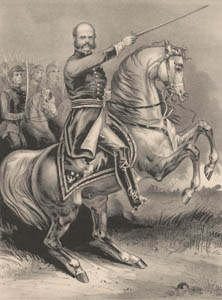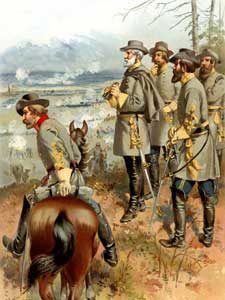The Fredericksburg Campaign was fought in and around Fredericksburg, Virginia, in the Eastern Theater of the Civil War. In November 1862, President Abraham Lincoln needed to demonstrate the Union war effort’s success before the Northern public lost confidence in his administration. Confederate armies had been on the move earlier in the fall, invading Kentucky and Maryland, and although each had been turned back, those armies remained intact and capable of further action. Lincoln urged Lieutenant General Ulysses S. Grant to advance against the Confederate stronghold of Vicksburg, Mississippi; replaced Major General Don Carlos Buell with Major General William S. Rosecrans, hoping for a more aggressive posture against the Confederates in Tennessee; and on November 5, seeing that his replacement of Buell had not stimulated Major General George B. McClellan into action, he issued orders to replace McClellan with Major General Ambrose E. Burnside.
Fredericksburg (December 11-15, 1862) – Also known as the Battle of Marye’s Heights, this large engagement involving more than 170,000 troops took place in Spotsylvania County and Fredericksburg. On November 14th, Major General Ambrose E. Burnside, now in command of the Army of the Potomac, sent a corps to occupy the vicinity of Falmouth near Fredericksburg.
The rest of the army soon followed. Confederate General Robert E. Lee reacted by entrenching his army on the heights behind the town. On December 11th, Union engineers laid five pontoon bridges across the Rappahannock River under fire. The next day, the Federal army crossed over, and on December 13th, General Burnside mounted a series of futile frontal assaults on Prospect Hill and Marye’s Heights that resulted in staggering casualties. On the Union’s left flank, General George Meade’s division briefly penetrated Confederate Major General Thomas J. Jackson’s line but was driven back by a counterattack. Union generals C. Feger Jackson and George Bayard, and Confederate generals Thomas R.R. Cobb and Maxey Gregg were killed. On December 15, General Burnside called off the offensive and re-crossed the river, ending the campaign. Burnside initiated a new offensive in January 1863, which quickly bogged down in the winter mud. The abortive “Mud March” and other failures led to General Burnside’s replacement by Major General Joseph Hooker in January 1863. The Confederate victory resulted in an estimated 13,353 Union casualties and 4,576 Confederate casualties. Remembered as one of the most one-sided battles of the war, one battlefield visitor described it as “butchery.”
Compiled and edited by Kathy Weiser-Alexander/Legends of America, updated May 2021.
Also See:
Sources:
Battlefields.org
National Park Service Battle Descriptions (no longer available online)
National Park Service Civil War



